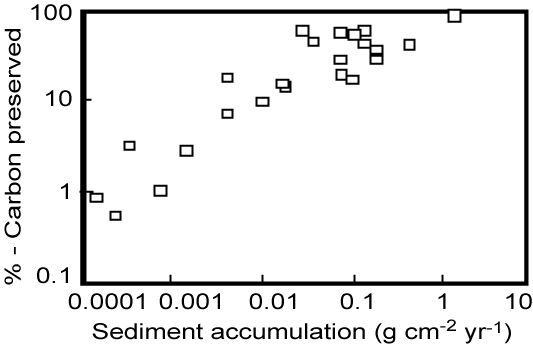


 |  |  | 12.4 Eutrophication effects |

For the benthic microbial community the most prominent effect of eutrophication is the increased loading of organic material to the seafloor. This stimulates the hydrolysis, the fermentation and the heterotrophic activity. Due to higher activity and diminished O2 concentration in the bottom water the oxic zone will shrink and the relative importance of the anaerobic degradation processes will increase. The reoxidation process of Mn2+, Fe2+ and H2S will move upward in the more reduced sediment and take place close to the sediment surface. Nitrification and denitification will diminish and nitrogen will leave the sediment in the form of ammonium rather than nitrate and dinitrogen. As the pool of ironoxides in the sediment is getting reduced, phosphor is released and will diffuse up in the overlying water. The sediment will now become an increasingly important source for phosphor, which can further stimulate rthe production in the water column. When the entire pool of ironoxides is used up the sulfide will reach the sediment water interface where a whitish lawn of the sulfide oxidizing bacteria develops. The heterotrophic degradation will now be completely dominated by sulfate reduction and the increased sulfide production may overload the sulfide oxidizers at the sediment surface requiring oxygen (or nitrate) for their activity. At this point sulfide escapes the seafloor and milky plumes of sulfur produced during chemical oxidation of the released sulfide will appear. Stimulated methan production will lead to bubble formations in the sediment. In extreme events bubbles will be released from the sediment leading to resuspension and further O2 depletion of the water column. Such events are commonly observed on a seasonal basis in coastal environments exposed to high levels of eutrophication like: Limfjorden in Denmark or Gulmarsfjorden in Sweden. In must instances the effect of eutrophication do not reach these extreme levels, but depending on the organic carbon loading the sediments will move along this cascade of events until the sedimentation of organic material diminish.
On longer time spans the increased loading of organic material affect the fraction of material that is buried in the sediment.
As can be seen above, the fraction of organic material that buried in the sediment increase with the sedimentation of organic material. Burial in the sediment thereby act as an increasingly important sink for organic material. This is not so much an effect of O2 depletion as an effect of exhausting the available oxidants of the anaerobic degradation.
 |  |  | 12.4 Eutrophication effects |